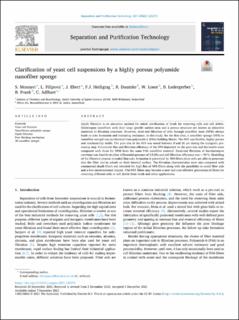Please use this identifier to cite or link to this item:
https://doi.org/10.21256/zhaw-23848Full metadata record
| DC Field | Value | Language |
|---|---|---|
| dc.contributor.author | Mousavi, Sara | - |
| dc.contributor.author | Filipová, Lucie | - |
| dc.contributor.author | Ebert, Jürgen | - |
| dc.contributor.author | Heiligtag, Florian Johannes | - |
| dc.contributor.author | Daumke, Ralph | - |
| dc.contributor.author | Loser, Werner | - |
| dc.contributor.author | Ledergerber, Bettina | - |
| dc.contributor.author | Frank, Brian | - |
| dc.contributor.author | Adlhart, Christian | - |
| dc.date.accessioned | 2022-01-07T11:53:06Z | - |
| dc.date.available | 2022-01-07T11:53:06Z | - |
| dc.date.issued | 2022 | - |
| dc.identifier.issn | 1383-5866 | de_CH |
| dc.identifier.issn | 1873-3794 | de_CH |
| dc.identifier.uri | https://digitalcollection.zhaw.ch/handle/11475/23848 | - |
| dc.description.abstract | Depth filtration is an attractive method for initial clarification of broth for removing cells and cell debris. Electrospun nanofibers with their large specific surface area and a porous structure are known as attractive materials in filtration processes. However, dead-end filtration of cells through nanofiber mats (NFM) always leads to cake formation and increasing resistance. In this study, for the first time, a nanofiber sponge (NFS) or nanofiber aerogel was synthetized from polyamide 6 (PA6) building blocks. The NFS was flexible, highly porous and mechanically stable. The pore size of the NFS was tuned between 8 and 26 µm during the cryogenic processing step. Volumetric flux and filtration efficiency of the NFS depended on the pore size and the results were compared with those for NFM from the same PA6 nanofiber material. Dead-end filtration of Saccharomyces cerevisiae was feasible at a low differential pressure of 3.5 kPa and cell filtration efficiency was > 99 %. Modelling of the filtration process revealed that cake formation is prevented by NFS filters since cells are able to penetrate into the filter and to adsorb on their internal surface. The filtration characteristics were also compared with commercial depth filters and revealed the high flux of NFS filters along with the possibility to avoid filter aids and a low environmental impact. PA6-NFS filters may become a new and cost effective generation of filters for removing different cells or cell debris from broth and other applications. | de_CH |
| dc.language.iso | en | de_CH |
| dc.publisher | Elsevier | de_CH |
| dc.relation.ispartof | Separation and Purification Technology | de_CH |
| dc.rights | http://creativecommons.org/licenses/by/4.0/ | de_CH |
| dc.subject | Yeast cell filtration | de_CH |
| dc.subject | Nanofibrous polyamide sponge | de_CH |
| dc.subject | Depth filtration | de_CH |
| dc.subject | Pore blocking mechanism | de_CH |
| dc.subject | 3D nanofiber aerogel | de_CH |
| dc.subject.ddc | 660: Technische Chemie | de_CH |
| dc.title | Clarification of yeast cell suspensions by a highly porous polyamide nanofiber sponge | de_CH |
| dc.type | Beitrag in wissenschaftlicher Zeitschrift | de_CH |
| dcterms.type | Text | de_CH |
| zhaw.departement | Life Sciences und Facility Management | de_CH |
| zhaw.organisationalunit | Institut für Chemie und Biotechnologie (ICBT) | de_CH |
| dc.identifier.doi | 10.1016/j.seppur.2021.120273 | de_CH |
| dc.identifier.doi | 10.21256/zhaw-23848 | - |
| zhaw.funding.eu | No | de_CH |
| zhaw.issue | 120273 | de_CH |
| zhaw.originated.zhaw | Yes | de_CH |
| zhaw.publication.status | publishedVersion | de_CH |
| zhaw.volume | 284 | de_CH |
| zhaw.publication.review | Peer review (Publikation) | de_CH |
| zhaw.webfeed | Funktionsmaterialien und Nanotechnologie | de_CH |
| zhaw.funding.zhaw | Nanofaserbasierte Aerogele für ein Filtrationssystem in biotechnologischen Downstream Prozessen | de_CH |
| zhaw.author.additional | No | de_CH |
| zhaw.display.portrait | Yes | de_CH |
| Appears in collections: | Publikationen Life Sciences und Facility Management | |
Files in This Item:
| File | Description | Size | Format | |
|---|---|---|---|---|
| 2022_Mousavi-etal_Clarification-of-yeast-cell-suspensions-porous-polyamide-nanofiber-sponge.pdf | 2.82 MB | Adobe PDF |  View/Open |
Show simple item record
Mousavi, S., Filipová, L., Ebert, J., Heiligtag, F. J., Daumke, R., Loser, W., Ledergerber, B., Frank, B., & Adlhart, C. (2022). Clarification of yeast cell suspensions by a highly porous polyamide nanofiber sponge. Separation and Purification Technology, 284(120273). https://doi.org/10.1016/j.seppur.2021.120273
Mousavi, S. et al. (2022) ‘Clarification of yeast cell suspensions by a highly porous polyamide nanofiber sponge’, Separation and Purification Technology, 284(120273). Available at: https://doi.org/10.1016/j.seppur.2021.120273.
S. Mousavi et al., “Clarification of yeast cell suspensions by a highly porous polyamide nanofiber sponge,” Separation and Purification Technology, vol. 284, no. 120273, 2022, doi: 10.1016/j.seppur.2021.120273.
MOUSAVI, Sara, Lucie FILIPOVÁ, Jürgen EBERT, Florian Johannes HEILIGTAG, Ralph DAUMKE, Werner LOSER, Bettina LEDERGERBER, Brian FRANK und Christian ADLHART, 2022. Clarification of yeast cell suspensions by a highly porous polyamide nanofiber sponge. Separation and Purification Technology. 2022. Bd. 284, Nr. 120273. DOI 10.1016/j.seppur.2021.120273
Mousavi, Sara, Lucie Filipová, Jürgen Ebert, Florian Johannes Heiligtag, Ralph Daumke, Werner Loser, Bettina Ledergerber, Brian Frank, and Christian Adlhart. 2022. “Clarification of Yeast Cell Suspensions by a Highly Porous Polyamide Nanofiber Sponge.” Separation and Purification Technology 284 (120273). https://doi.org/10.1016/j.seppur.2021.120273.
Mousavi, Sara, et al. “Clarification of Yeast Cell Suspensions by a Highly Porous Polyamide Nanofiber Sponge.” Separation and Purification Technology, vol. 284, no. 120273, 2022, https://doi.org/10.1016/j.seppur.2021.120273.
Items in DSpace are protected by copyright, with all rights reserved, unless otherwise indicated.